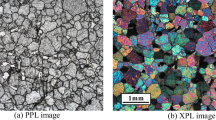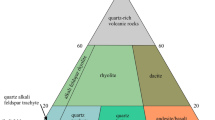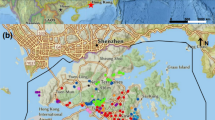Abstract
Rock classification from petrographic thin section analysis often requires expertise in mineralogy. This study developed a deep learning approach based on a convolutional neural network (CNN) to classify six igneous rock types from their thin section images. Petrographic image dataset with various image conditions was prepared and processed to train and evaluate the network model. The results from two different test methods demonstrated that the classification accuracy was higher when the classification scores of partitioned image patches were summed for an original image (Test A method) than when those of each partitioned image patch were individually predicted (Test B method). Nevertheless, both methods resulted in higher than 90% accuracy, proving that partitioned image-based classification could be suitable for petrographic images with various conditions. The features identified by the ResNet152 model were qualitatively evaluated by applying gradient-weighted class activation mapping (Grad-CAM) to the last convolutional layer. The correctly classified images showed well-perceived mineral grains and the associated matrix as visualized by Grad-CAM. It implied that CNN-based models could successfully identify morphological characteristics within an image similar to the human-based approach, leading to a reliable and explainable method for rock classification.








Similar content being viewed by others
References
Asmussen P, Conrad O, Günther A, Kirsch M, Riller U (2015) Semi-automatic segmentation of petrographic thin section images using a “seeded-region growing algorithm” with an application to characterize wheathered subarkose sandstone. Comput Geosci 83:89–99. https://doi.org/10.1016/j.cageo.2015.05.001
Baykan NA, Yilmaz N (2010) Mineral identification using color spaces and artificial neural networks. Comput Geosci 36:91–97. https://doi.org/10.1016/j.cageo.2009.04.009
Borazjani O, Ghiasi-Freez J, Hatampour A (2016) Two intelligent pattern recognition models for automatic identification of textural and pore space characteristics of the carbonate reservoir rocks using thin section images. J Nat Gas Sci Eng 35:944–955. https://doi.org/10.1016/j.jngse.2016.09.048
Borges HP, de Aguiar MS (2019) Mineral classification using machine learning and images of microscopic rock thin section. In: Mexican international conference on artificial intelligence. Springer, Cham, pp 63–76
Budennyy S, Pachezhertsev A, Bukharev A, Erofeev A, Mitrushkin D, Belozerov B (2017) Image processing and machine learning approaches for petrographic thin section analysis. In: SPE Russian Petroleum Technology Conference. OnePetro
Cheng G, Guo W (2017) Rock images classification by using deep convolution neural network. J Phys Conf Ser 887:012089. https://doi.org/10.1088/1742-6596/887/1/012089
Ercit TS (2005) Identification and alteration trends of granitic-pegmatite-hosted (Y,REE,U,Th)-(Nb,Ta,Ti) oxide minerals: a statistical approach. Can Mineral 43:1291–1303. https://doi.org/10.2113/gscanmin.43.4.1291
Götze J (2002) Potential of cathodoluminescence (CL) microscopy and spectroscopy for the analysis of minerals and materials. Anal Bioanal Chem 374:703–708. https://doi.org/10.1007/s00216-002-1461-1
Guojian C, Peisong L (2021) Rock thin-section image classification based on residual neural network. In: 2021 6th international conference on intelligent computing and signal processing (ICSP). IEEE, 521–524
Hanan MA, Totten MW (1996) Analytical techniques for the separation and SEM identification of heavy minerals in mudrocks. J Sediment Res 66:1027–1030
Hatch FH (1891) An introduction to the study of petrology: the igneous rocks. S. Sonnenschein & Company
He K, Zhang X, Ren S, Sun J (2016) Deep residual learning for image recognition. In: Proceedings of the IEEE Computer Society Conference on Computer Vision and Pattern Recognition. IEEE, 770–778. https://doi.org/10.1109/CVPR.2016.90
Hull AW (1917) A new method of X-ray crystal analysis. Phys Rev 10:661–696
Izadi H, Sadri J, Mehran NA (2013) A new approach to apply texture features in minerals identification in petrographic thin sections using ANNs. In: 2013 8th Iranian conference on machine vision and image processing (MVIP). IEEE, 257–261. https://doi.org/10.1109/IranianMVIP.2013.6779990
Joseph S, Ujir H, Hipiny I (2017) Unsupervised classification of intrusive igneous rock thin section images using edge detection and colour analysis. In: 2017 IEEE international conference on signal and image processing applications (ICSIPA). IEEE, 530–534
Koh EJY, Amini E, McLachlan GJ, Beaton N (2021) Utilising convolutional neural networks to perform fast automated modal mineralogy analysis for thin-section optical microscopy. Miner Eng 173:107230. https://doi.org/10.1016/j.mineng.2021.107230
Ma Z, Gao S (2017) Image analysis of rock thin section based on machine learning. In: International Geophysical Conference, Qingdao, China, 17–20 April 2017. Society of Exploration Geophysicists and Chinese Petroleum Society, 844–847
Mead WJ, Swanson CO (1924) X-ray determination of minerals. Econ Geol 19:486–489
Młynarczuk M, Górszczyk A, Ślipek B (2013) The application of pattern recognition in the automatic classification of microscopic rock images. Comput Geosci 60:126–133. https://doi.org/10.1016/j.cageo.2013.07.015
Norrish K, Taylor R (1962) Quantitative analysis by X-ray diffraction. Clay Miner Bull 5:98–109
Pan SJ, Yang Q (2009) A survey on transfer learning. IEEE Trans Knowl Data Eng 22:1345–1359
Paszke A, Gross S, Massa F, Lerer A, Bradbury J, Chanan G, Killeen T, Lin Z, Gimelshein N, Antiga L (2019) Pytorch: an imperative style, high-performance deep learning library. Adv Neural Inf Proces Syst 32
Peacock MA (1931) Classification of igneous rock series. J Geol 39:54–67
Pires de Lima R, Duarte D (2021) Pretraining convolutional neural networks for mudstone petrographic thin-section image classification. Geosciences 11(8):1–25. https://doi.org/10.3390/GEOSCIENCES11080336
Pires de Lima R, Duarte D, Nicholson C, Slatt R, Marfurt KJ (2020) Petrographic microfacies classification with deep convolutional neural networks. Comput Geosci 142:104481. https://doi.org/10.1016/j.cageo.2020.104481
Polat Ö, Polat A, Ekici T (2021a) Automatic classification of volcanic rocks from thin section images using transfer learning networks. Neural Comput Appl 33:1–10. https://doi.org/10.1007/s00521-021-05849-3
Polat Ö, Polat A, Ekici T (2021b) Classification of plutonic rock types using thin section images with deep transfer learning. Turk J Earth Sci 30(4):551–560
Selvaraju RR, Cogswell M, Das A, Vedantam R, Parikh D, Batra D (2017) Grad-cam: visual explanations from deep networks via gradient-based localization. In: Proceedings of the IEEE International Conference on Computer Vision, pp 618–626
Simonyan K, Zisserman A (2014) Very deep convolutional networks for large-scale image recognition. arXiv preprint arXiv:1409.1556
Smithson F (1948) The application of phase-contrast microscopy to mineralogy and petrology. Mineral Mag J M Soc 28:384–391. https://doi.org/10.1180/minmag.1948.028.202.06
Su C, Xu S, Zhu K, Zhang X (2020) Rock classification in petrographic thin section images based on concatenated convolutional neural networks. Earth Sci Inform 13:1477–1484. https://doi.org/10.1007/s12145-020-00505-1
Zeiler MD, Fergus R (2014) Visualizing and understanding convolutional networks. In: European conference on computer vision. Springer, Cham, pp 818–833
Acknowledgements
This work was supported by the National Research Foundation of Korea (NRF) grant funded by the Korea government (MSIT) (Nos. 2020R1A2C1014815, NRF-2021R1A5A1032433). This work is based in part on data from “Alessandro Da Mommio, Department of Earth Sciences “Ardito Desio”, Università degli Studi di Milano, Milan, Italy” and “Korea Institute of Geoscience and Mineral Resources”.
Author information
Authors and Affiliations
Contributions
Wanhyuk Seo: Methodology, Software, Formal analysis, Investigation, Writing – Original Draft. Yejin Kim: Validation, Formal analysis, Writing – Review & Editing. Ho Sim: Validation, Resources, Writing – Original Draft. Yungoo Song: Conceptualization, Resources. Tae Sup Yun: Conceptualization, Validation, Formal analysis, Writing – Review & Editing.
Corresponding author
Ethics declarations
Conflict of interest
The authors declare that they have no known competing financial interests or personal relationships that could have appeared to influence the work reported in this paper.
Additional information
Communicated by: H. Babaie
Publisher’s note
Springer Nature remains neutral with regard to jurisdictional claims in published maps and institutional affiliations.
Rights and permissions
About this article
Cite this article
Seo, W., Kim, Y., Sim, H. et al. Classification of igneous rocks from petrographic thin section images using convolutional neural network. Earth Sci Inform 15, 1297–1307 (2022). https://doi.org/10.1007/s12145-022-00808-5
Received:
Accepted:
Published:
Issue Date:
DOI: https://doi.org/10.1007/s12145-022-00808-5




